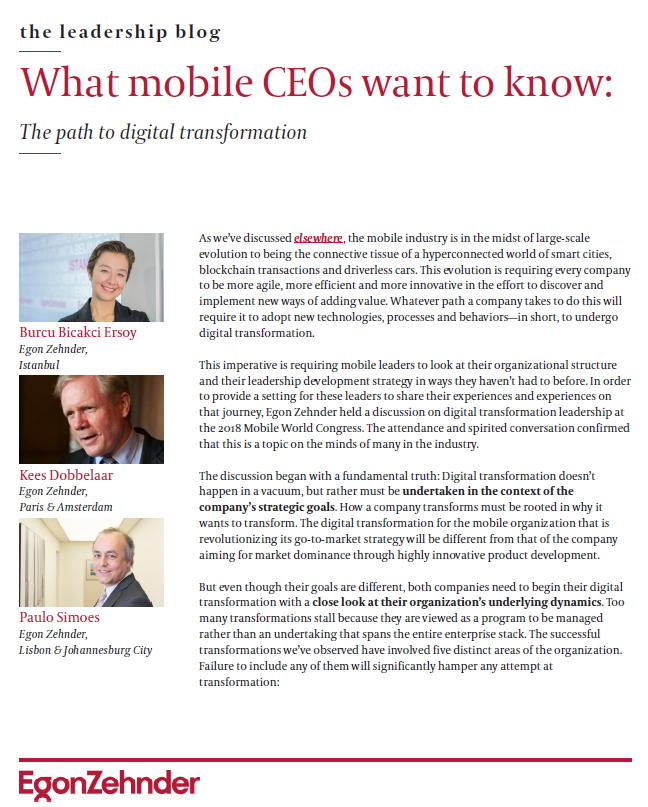As we’ve discussed elsewhere, the mobile industry is in the midst of large-scale evolution to being the connective tissue of a hyperconnected world of smart cities, blockchain transactions and driverless cars. This evolution is requiring every company to be more agile, more efficient and more innovative in the effort to discover and implement new ways of adding value. Whatever path a company takes to do this will require it to adopt new technologies, processes and behaviors—in short, to undergo digital transformation.
This imperative is requiring mobile leaders to look at their organizational structure and their leadership development strategy in ways they haven’t had to before. In order to provide a setting for these leaders to share their experiences and experiences on that journey, Egon Zehnder held a discussion on digital transformation leadership at the 2018 Mobile World Congress. The attendance and spirited conversation confirmed that this is a topic on the minds of many in the industry.
The discussion began with a fundamental truth: Digital transformation doesn’t happen in a vacuum, but rather must be undertaken in the context of the company’s strategic goals. How a company transforms must be rooted in why it wants to transform. The digital transformation for the mobile organization that is revolutionizing its go-to-market strategy will be different from that of the company aiming for market dominance through highly innovative product development.
But even though their goals are different, both companies need to begin their digital transformation with a close look at their organization’s underlying dynamics. Too many transformations stall because they are viewed as a program to be managed rather than an undertaking that spans the entire enterprise stack. The successful transformations we’ve observed have involved five distinct areas of the organization. Failure to include any of them will significantly hamper any attempt at transformation:
- Culture: Hierarchy and bureaucracy need to give way to agility and entrepreneurialism, with close attention paid to the human and cultural sides of digital transformation.
- Customer centricity: Digitally transforming companies need to think about every initiative with the customer in mind and develop an integrated omnichannel strategy that stays ahead of those customers’ continually rising expectations regarding usability and convenience.
- Performance: KPIs must expand past traditional “hard” metrics like EBITDA to include behaviors like experimentation and change leadership. As several attendees noted, culture change in large organizations is best accomplished by constant reinforcement of a few key behaviors.
- Innovation: A framework needs to be established to foster new ideas, test those ideas against each other and let them combine and morph into unexpected solutions.
- Operations: The workings of the organization need to be restructured to allow for greater efficiency and more seamless collaboration across functions and business units. Even though digital transformation involves much more than technology, IT is central to the undertaking. As one of the attendees remarked, “If the kitchen fails, everything else fails as well.”
Close examination of these organizational dynamics can lead companies in a variety of directions. As one of the attendees observed, several mobile companies have concluded that they can create the greatest value by spinning off highly innovative divisions into independent entities.
Whatever strategy is followed, it is clear from the above that digital transformation requires digitally minded leaders throughout the organization who can guide the company along this path while continuing to meet the demands of an ongoing business. These leaders combine their domain expertise—whether in operations, marketing or human resources—with a digital mindset.
In working with many mobile companies to build digital transformation teams, we have found that digitally minded leaders have three sets of traits. First, they need the right experience and personal characteristics, including customer focus, data centricity, agility and startup/incubation experience. Second, they need the right competencies, including strategic orientation, market insight and change leadership. Finally, they also need the right combination of curiosity, insight, determination and engagement. These four traits combine to form what we at Egon Zehnder call an executive’s potential – his or her ability to adapt to unforeseen circumstances in a way that past experience and current competencies alone can’t predict.1
Note that the combination of the traits needed by a candidate will vary depending on the role. A business model innovator will be stronger on customer centricity, strategic orientation and insight than someone asked to lead the transformation of operational processes, who will need to be stronger in change leadership, determination and data centricity. No matter the role, however, curiosity is critical. A desire to ask questions and an appetite to learn beyond the horizons of the task at hand are now absolutely essential to keep pace with a digitally transforming world.
Many mobile companies have made significant strides in transforming their organizations and developing and retaining the talent they need to do so. As one attendee pointedly noted, the industry does not have to go to Silicon Valley for its digital talent. But mobile organizations cannot rest on their laurels; the competition for talent is simply too great.
In summary, having a clear framework for digital transformation leadership will help companies continue to refine their management of internal talent in the same way that they continue to advance their technologies and product offerings. Companies that do so will have both a valuable strategic resource and will be making a powerful statement about their vision for mobile’s digital future and their place in it.
1For more on Egon Zehnder’s Potential Model, see “21-Century Talent Spotting” by Claudio Fernández-Aráoz in the June 2014 issue of Harvard Business Review.






